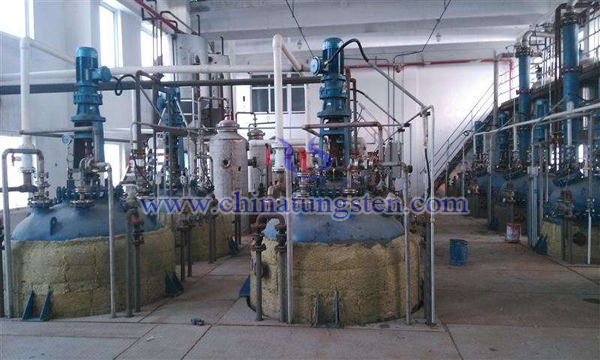Dicyclopentadiene Dioxide Catalyzed by Quaternary Ammonium Salt of Phosphotungstic Heteropolyacid
- Details
- Category: Tungsten Information
- Published on Monday, 04 March 2019 21:49
Dicyclopentadiene dioxide is a kind of alicyclic epoxide with excellent properties. It has excellent weatherability, heat resistance, high hardness and good electrical insulation. It is used in high temperature casting materials, glass fibre reinforced plastics, adhesives, laminates and packaging of electronic devices. This material is usually prepared by epoxidation of dicyclopentadiene, and strong acid catalyst is needed in the reaction process.

Preparation of dicyclopentadiene dioxide using the obtained quaternary ammonium phosphate-tungsten heteropolyacid catalyst. 125 ml 1,2-dichloroethane, 25 ml (0.185 mol) dicyclopentadiene and 0.99 g (5.1 x 10-4 mol) catalyst 2 were added to 250 ml four-port flask. Hydrogen peroxide with a weight percentage of 27.2 ml (0.472 mol) was added to the flask one by one, and the temperature of the reactor could not exceed 50 ℃. After adding hydrogen peroxide droplets, the reaction continued for 12 hours at 60 ℃ and the reaction was carried out directly from the liquid transfer tube. Two ml samples were taken for analysis, and 1,2-dichloroethane was recovered by vacuum distillation and then cooled to room temperature to remove the water in the reactor. Then 250 ml ethyl acetate was used to dissolve the residue twice and filter it to get catalyst. After recovering the organic solvent of ethyl acetate from the filtrate by vacuum distillation, the crude product was obtained, and then the White was obtained by recrystallization using the mixed solvent of ethyl acetate and petroleum ether whose volume ratio was 1:4. Powdery solid, vacuum dried to constant weight at 50 ℃.
In the reaction process, the catalyst forms active species which are soluble in the reaction solution under the action of hydrogen peroxide. The active species continue to catalyze the epoxidation reaction with dicyclopentadiene to synthesize dicyclopentadiene dioxide. It has excellent catalytic effect, short process, safe working environment, high product yield and purity. Moreover, the catalyst can be separated and recovered. The agent can be reused without drying and can be directly used in the next reaction, thus effectively reducing production costs.
- Tungsten Oxide Manufacturer & Supplier, Chinatungsten Online: www.tungsten-oxide.com
- Tungsten News & Prices of China Tungsten Industry Association: www.ctia.com.cn
- Molybdenum News & Price: news.molybdenum.com.cn
- Tel.: 86 592 5129696; Fax: 86 592 5129797; Email: sales@chinatungsten.com